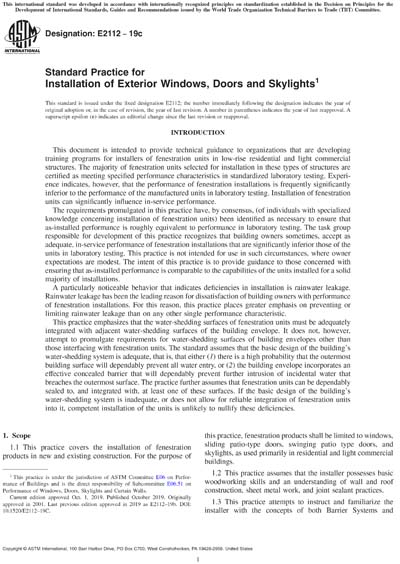Historical
ASTM E2112-19c
Standard Practice for Installation of Exterior Windows, Doors and Skylights
1.1 This practice covers the installation of fenestration products in new and existing construction. For the purpose of this practice, fenestration products shall be limited to windows, sliding patio-type doors, swinging patio type doors, and skylights, as used primarily in residential and light commercial buildings.
1.2 This practice assumes that the installer possesses basic woodworking skills and an understanding of wall and roof construction, sheet metal work, and joint sealant practices.
1.3 This practice attempts to instruct and familiarize the installer with the concepts of both Barrier Systems and Membrane/Drainage Systems, in order to ensure the continuity of the building envelope. This practice attempts to educate the installer, builder, architect, and other users in the identification and understanding of the water shedding system of the building envelope.
1.4 This practice covers the installation process from pre-installation procedures through post-installation procedures, for single units or factory-mulled multiple units in a single opening. It does not cover the fabrication or assembly of multiple units, whether such fabrication takes place in a factory or at the intended installation site. The installer should check with the manufacturer of factory-assembled units for instructions for anchoring. When using field-mulled units, follow manufacturer's recommendations and make certain that they meet applicable codes. This practice does not cover the selection of appropriate fenestration products for a given application, nor the selection of other products or systems for use in the installation.
1.5 This practice provides minimum requirements that will help to accomplish the installation of fenestration products in an effective manner. Actual conditions in buildings vary greatly and, in some cases, substantial additional precautions may be required. In the event that the manufacturer's installation instructions provided with the product conflict with requirements of this practice, the manufacturer's instructions shall prevail. This practice is not intended to limit or exclude other new procedures that may refine or further improve the effectiveness of fenestration installation.
1.5.1 This practice is intended to be used for background information in order to develop training manuals and training programs. Further, this practice attempts to consolidate and unify the various steps of construction, tying together the various trades involved with the continuity between fenestration products and the building envelope.
1.6 The text of this practice references notes and footnotes that provide explanatory material. These notes and footnotes (excluding those in tables and figures) shall not be considered as requirements of this practice.
1.7 This standard has not been created to address all issues related to every possible installation situation one might experience in the field. Furthermore, this practice does not purport to provide fail-safe installation methods, assurance or protection against installation deficiencies, or a standard by which architects can specify or ensure delivered performance.
Note 1: There are no ISO standards covering the primary subject matter of this practice.
1.8 Design Professional—This practice is not intended to limit the role and authority of a registered design professional to select a method of installation or to change, modify, or develop other methods of installation to meet the specific requirements of a building project for a particular location. A design professional retains the authority to prepare construction documents indicating window/door/skylight installations integrated with the water-resistive barrier (WRB).
1.9 The values stated in inch-pound units are to be regarded as standard. The values given in parentheses are mathematical conversions to SI units that are provided for information only and are not considered standard.
1.10 This practice does not purport to address all of the safety concerns, if any, associated with its use. It is the responsibility of the user of this standard to establish appropriate safety, health, and environmental practices and to determine the applicability of regulatory limitations prior to use. For specific precautionary statements, see Section 5, Related Procedures. Where a lead hazard is known or suspected, refer to ASTM Standards on Lead Hazards Associated with Buildings and to applicable state and federal regulations. Where an asbestos hazard is known or suspected, refer to the ASTM Manual on Asbestos Control, and to applicable state and federal regulations.
1.11 Table of Contents:
1.12 This international standard was developed in accordance with internationally recognized principles on standardization established in the Decision on Principles for the Development of International Standards, Guides and Recommendations issued by the World Trade Organization Technical Barriers to Trade (TBT) Committee.
Content Provider
ASTM International [astm]






